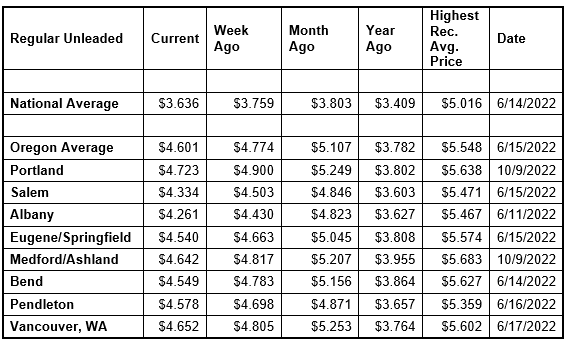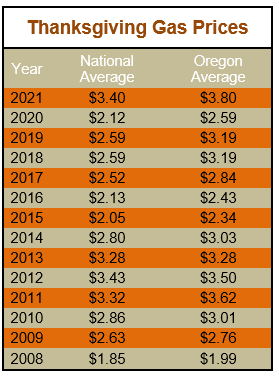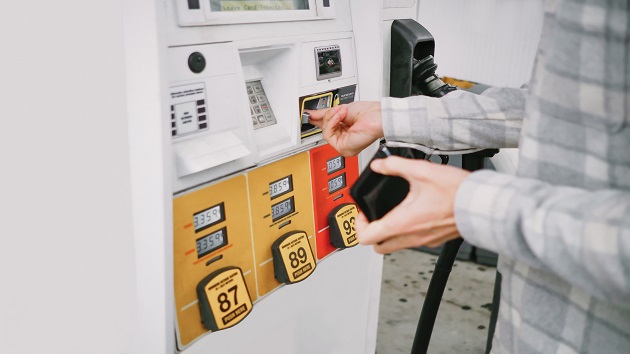Drivers fueling up ahead of Thanksgiving will find falling pump prices in all 50 states. Unfortunately, gas prices will be the most expensive ever for the holiday. For the week, the national average for regular tumbles 12 cents to $3.76 a gallon. The Oregon average plunges 17 cents to $4.77. This is the fifth-largest weekly drop for a state in the nation.

AAA projects 54.6 million Americans (16.4% of the population) will travel 50 miles or more from home for the Thanksgiving holiday, up 1.5% from 2021. This year is expected to be the third-busiest for Thanksgiving travel since AAA started tracking in 2000, only behind 2005 and 2019. About 777,000 Oregonians will head over the river and through the woods for turkey and all the trimmings. Find details and tips for travelers in the AAA Thanksgiving news release.
“Gas prices have never been more expensive for Thanksgiving with the national and Oregon averages at their highest prices ever for the holiday. Those who hit the road for Thanksgiving will find gas prices that are as much as 90 cents a gallon more expensive than last year,” says Marie Dodds, public affairs director for AAA Oregon/Idaho. “Still, we can be thankful that pump prices are moving in the right direction for now.

Crude oil prices are at their lowest prices in 10 months and that’s helping to put downward pressure on pump prices. Crude prices remained in a fairly tight range between about $85 and $93 per barrel for several weeks until this week when prices fell to $80 as markets focused on a potential slowdown for global economies, driven by the seemingly increasing COVID-19 outbreak in China.
Crude oil prices climbed above $90 briefly earlier this month. Crude reached a recent high of $122.11 per barrel on June 8, and ranged from about $94 to $110 per barrel in July. In August, crude prices ranged between about $86 and $97. In September, crude prices ranged between about $76 and $88 per barrel. In October, crude ranged between $82 and $92 per barrel.
Crude prices rose dramatically leading up to and in the first few months of Russia’s invasion of Ukraine. Russia is one of the world’s top oil producers and its involvement in a war causes market volatility, and sanctions imposed on Russia by the U.S. and other western nations resulted in tighter global oil supplies. Oil supplies were already tight around the world as demand for oil increased as pandemic restrictions eased. A year ago, crude was around $77 per barrel compared to $81 today.
Crude oil is the main ingredient in gasoline and diesel, so pump prices are impacted by crude prices on the global markets. On average, about 56% of what we pay for in a gallon of gasoline is for the price of crude oil, 20% is refining, 11% distribution and marketing, and 14% are taxes, according to the U.S. Energy Information Administration.
Demand for gasoline in the U.S. fell from 9.01 million to 8.74 million b/d for the week ending November 11.
This compares to 9.24 million b/d at this time last year. rose by nearly 2.2 million bbl to 207.9 million bbl. Increasing supply and falling demand have helped to push pump prices lower. As demand remains low and stocks grow, drivers will likely see pump prices dip through the Thanksgiving holiday.
Quick stats
Pump prices are lower this week in all 50 states and the District of Columbia. Wisconsin (-24 cents) has the largest weekly drop. Hawaii (-1 cent) has the smallest weekly decline.
California ($5.12) has the most expensive gas in the country for the 11th week in a row. California and Hawaii ($5.20) are the only two states with averages at or above $5 a gallon. This week nine states, including Oregon, have averages at or above $4, and 41 states and the District of Columbia have averages in the $3-range.
The cheapest gas in the nation is in Texas ($2.98) and Georgia ($3.09). For the 98th week in a row, no state has an average below $2 a gallon.
The difference between the most expensive and least expensive states is $2.23 which continues to be stark.
Oregon is one of 39 states and the District of Columbia with lower prices now than a month ago. The national average is 17 cents less and the Oregon average is 51 cents less than a month ago. Oregon has the third-largest monthly decrease in the nation. California (-58 cents) and Alaska (-55 cents) have the largest monthly declines. Maine (+22 cents) has the largest month-over-month increase.
Oregon is one of 47 states and the District of Columbia with higher prices now than a year ago. The national average is 23 cents more and the Oregon average is 82 cents more than a year ago. This is the fourth-largest year-over-year increase in the nation. Alaska (+87 cents) and Hawaii (+86 cents) have the largest yearly gains. Georgia (-14 cents) has the biggest year-over-year decline.






